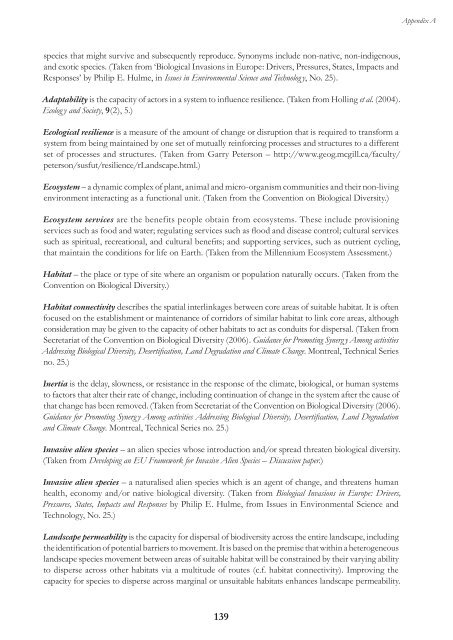Twenty-eighth Report Adapting Institutions to Climate Change Cm ...
Twenty-eighth Report Adapting Institutions to Climate Change Cm ...
Twenty-eighth Report Adapting Institutions to Climate Change Cm ...
You also want an ePaper? Increase the reach of your titles
YUMPU automatically turns print PDFs into web optimized ePapers that Google loves.
species that might survive and subsequently reproduce. Synonyms include non-native, non-indigenous,<br />
and exotic species. (Taken from ‘Biological Invasions in Europe: Drivers, Pressures, States, Impacts and<br />
Responses’ by Philip E. Hulme, in Issues in Environmental Science and Technolog y, No. 25).<br />
Adaptability is the capacity of ac<strong>to</strong>rs in a system <strong>to</strong> influence resilience. (Taken from Holling et al. (2004).<br />
Ecolog y and Society, 9(2), 5.)<br />
Ecological resilience is a measure of the amount of change or disruption that is required <strong>to</strong> transform a<br />
system from being maintained by one set of mutually reinforcing processes and structures <strong>to</strong> a different<br />
set of processes and structures. (Taken from Garry Peterson – http://www.geog.mcgill.ca/faculty/<br />
peterson/susfut/resilience/rLandscape.html.)<br />
Ecosystem – a dynamic complex of plant, animal and micro-organism communities and their non-living<br />
environment interacting as a functional unit. (Taken from the Convention on Biological Diversity.)<br />
Ecosystem services are the benefits people obtain from ecosystems. These include provisioning<br />
services such as food and water; regulating services such as flood and disease control; cultural services<br />
such as spiritual, recreational, and cultural benefits; and supporting services, such as nutrient cycling,<br />
that maintain the conditions for life on Earth. (Taken from the Millennium Ecosystem Assessment.)<br />
Habitat – the place or type of site where an organism or population naturally occurs. (Taken from the<br />
Convention on Biological Diversity.)<br />
Habitat connectivity describes the spatial interlinkages between core areas of suitable habitat. It is often<br />
focused on the establishment or maintenance of corridors of similar habitat <strong>to</strong> link core areas, although<br />
consideration may be given <strong>to</strong> the capacity of other habitats <strong>to</strong> act as conduits for dispersal. (Taken from<br />
Secretariat of the Convention on Biological Diversity (2006). Guidance for Promoting Synerg y Among activities<br />
Addressing Biological Diversity, Desertification, Land Degradation and <strong>Climate</strong> <strong>Change</strong>. Montreal, Technical Series<br />
no. 25.)<br />
Inertia is the delay, slowness, or resistance in the response of the climate, biological, or human systems<br />
<strong>to</strong> fac<strong>to</strong>rs that alter their rate of change, including continuation of change in the system after the cause of<br />
that change has been removed. (Taken from Secretariat of the Convention on Biological Diversity (2006).<br />
Guidance for Promoting Synerg y Among activities Addressing Biological Diversity, Desertification, Land Degradation<br />
and <strong>Climate</strong> <strong>Change</strong>. Montreal, Technical Series no. 25.)<br />
Invasive alien species – an alien species whose introduction and/or spread threaten biological diversity.<br />
(Taken from Developing an EU Framework for Invasive Alien Species – Discussion paper.)<br />
Invasive alien species – a naturalised alien species which is an agent of change, and threatens human<br />
health, economy and/or native biological diversity. (Taken from Biological Invasions in Europe: Drivers,<br />
Pressures, States, Impacts and Responses by Philip E. Hulme, from Issues in Environmental Science and<br />
Technology, No. 25.)<br />
Landscape permeability is the capacity for dispersal of biodiversity across the entire landscape, including<br />
the identification of potential barriers <strong>to</strong> movement. It is based on the premise that within a heterogeneous<br />
landscape species movement between areas of suitable habitat will be constrained by their varying ability<br />
<strong>to</strong> disperse across other habitats via a multitude of routes (c.f. habitat connectivity). Improving the<br />
capacity for species <strong>to</strong> disperse across marginal or unsuitable habitats enhances landscape permeability.<br />
139<br />
Appendix A
















